Chopard
Introducing the Chopard L.U.C 1860 Flying T, Special Revolution
Small Is Beautiful
While the header to this paragraph could easily allude to my very public penchant for sausage dogs, it in fact references what I genuinely believe is one of the most important tourbillon wristwatches of all time. I speak, of course, of the new Chopard L.U.C Flying T Twin that is made in just five examples, in collaboration with Revolution, aka the L.U.C 1860 Flying T, Special Revolution.
If that statement seems biased or self-serving, let me explain myself. For the most part, the Swiss watch industry has found itself caught slightly out of step when it comes to the size of their wristwatches. Conjure up your horological Valhalla of the most iconic and desirable timepieces ever created. Who appears in those mythical halls?
A steel Patek ref. 1518? Sure! The dial measures 35mm in diameter. The Patek first-generation ref. 2499 with its square pushers and tachymeter? Absolutely. The dial measures 37.5mm. A Philippe Dufour Simplicity? Damn right. Did you know its original size was 34mm? He only created the 37mm size at the behest of four Singaporean clients of The Hour Glass. Ask him, and he will tell you that he far prefers the smaller size that he’d originally designed. I think you get my point.
So, why is it that almost all watch brands make complicated dress watches in sizes exceeding 40mm in diameter? The answer is simple. Maisons that invested in manufacturing these complications in-house, did so during the late ’90s and early 2000s — which was exactly the time the trend for oversized watches emerged. I chose the word “trend” carefully, but with respect, I genuinely feel that these behemoths are the result of a two-decade-long trend rather than what is genuinely the perfect classic size. So, why is it that none of these brands have scaled down their watches to be in alignment with the aesthetic dictates that prevailed over the near-120 years of history of the modern wristwatch? The answer to this is also simple. They can’t — or they won’t. Because that would involve a vast and costly complete re-engineering of their movements.
Proof Positive
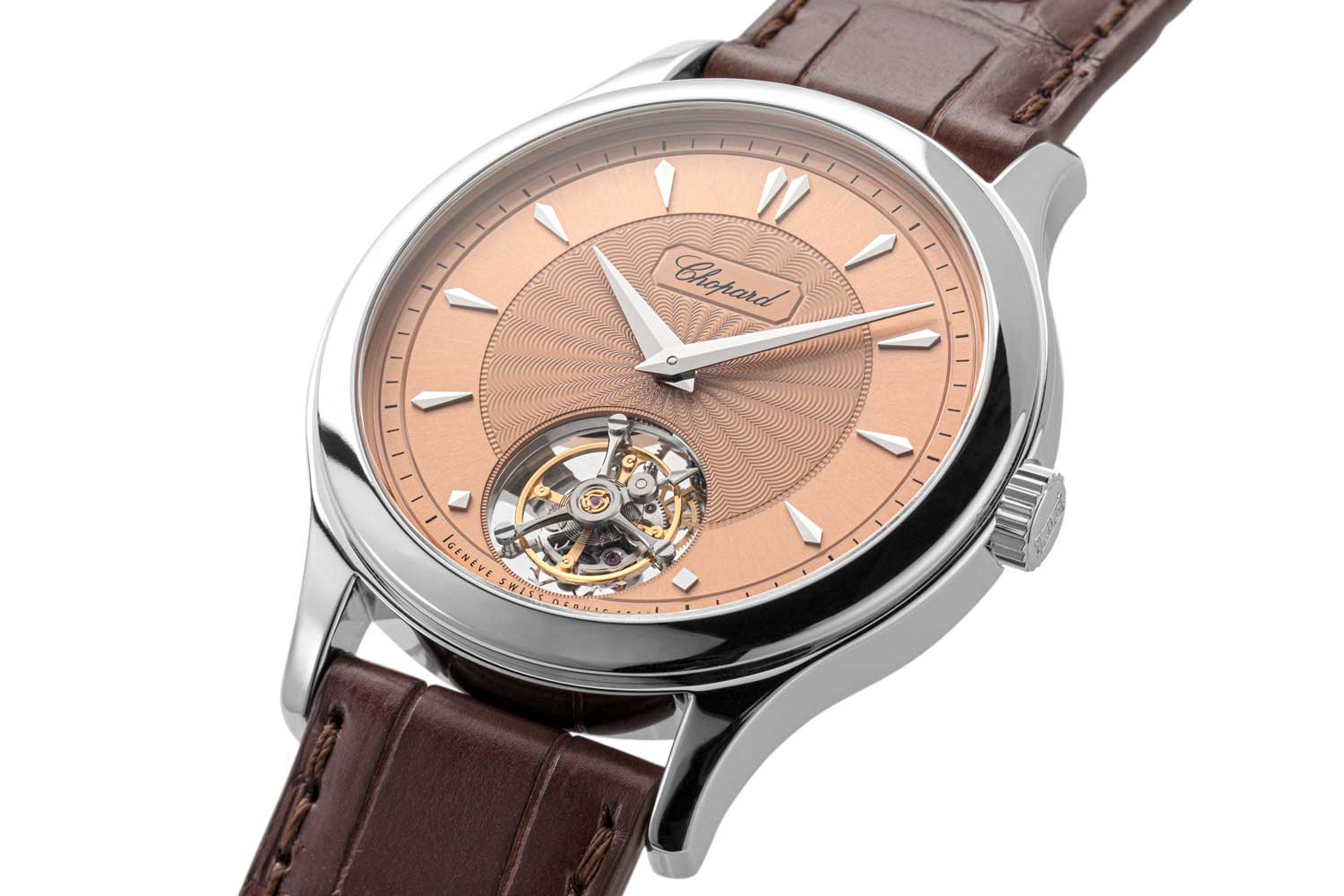
The 36.5 mm in diameter and 8.2 mm in height, Chopard L.U.C 1860 Flying T, Special Revolution equipped with a 3.5 Hz flying tourbillon; the watch boasts both the Poinçon de Genève and COSC certification (©Revolution)
Personally, I feel any tourbillon that does not come with some credible form of a certification for its accuracy, is simply a visually amusing spinning device on your dial. Perhaps most importantly, it is a symbol of a quarter-century of relentless groundbreaking technical innovation and dedication to both chronometry and excellence in finish that is Chopard L.U.C. Indeed, this watch is a celebration of the 25th anniversary of this remarkable brand, and a ticking testimony to the extraordinary commitment to authenticity and quality that form the central ethos of its founder, the amazing Karl-Friedrich Scheufele.
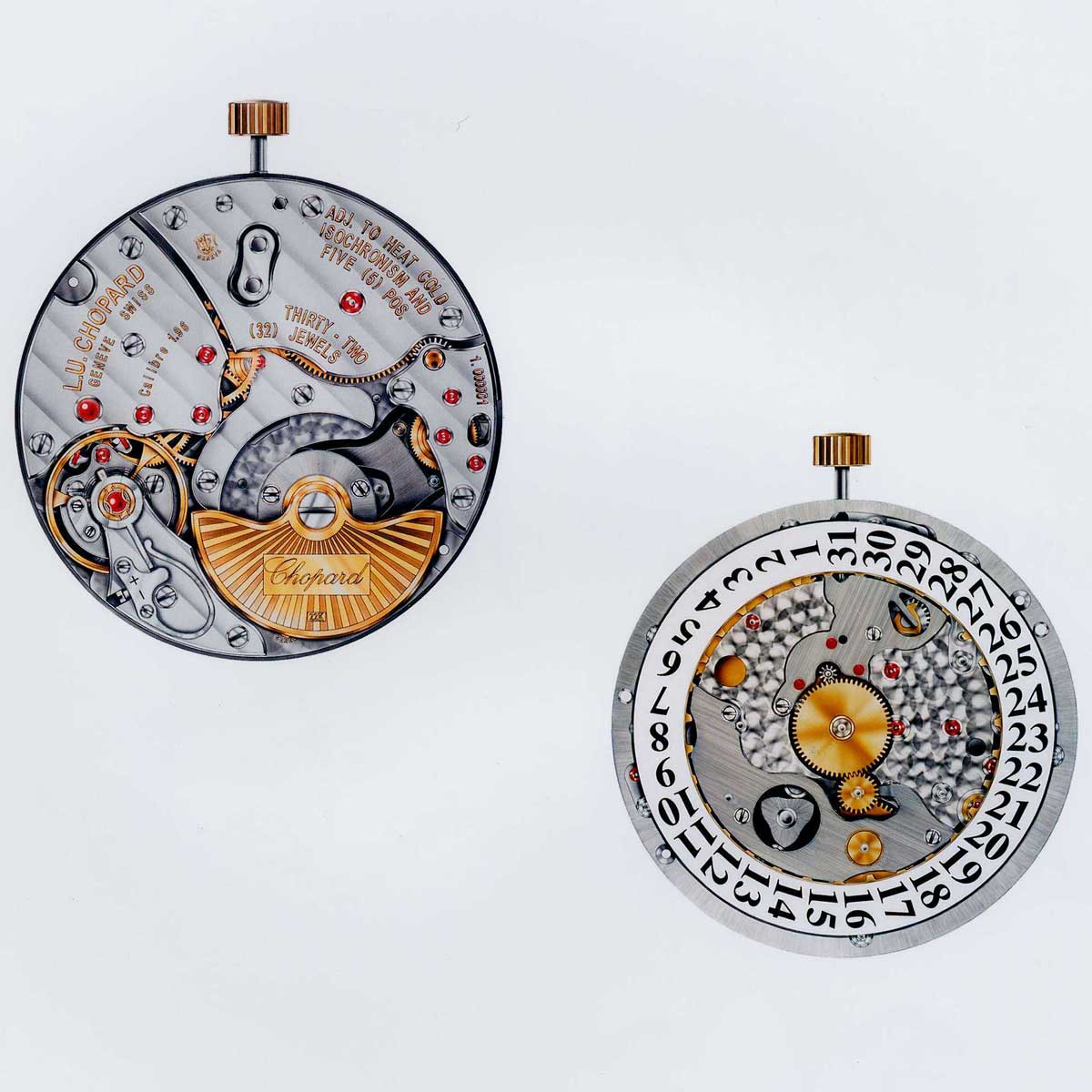
1996 — The Calibre 1.96 is unveiled
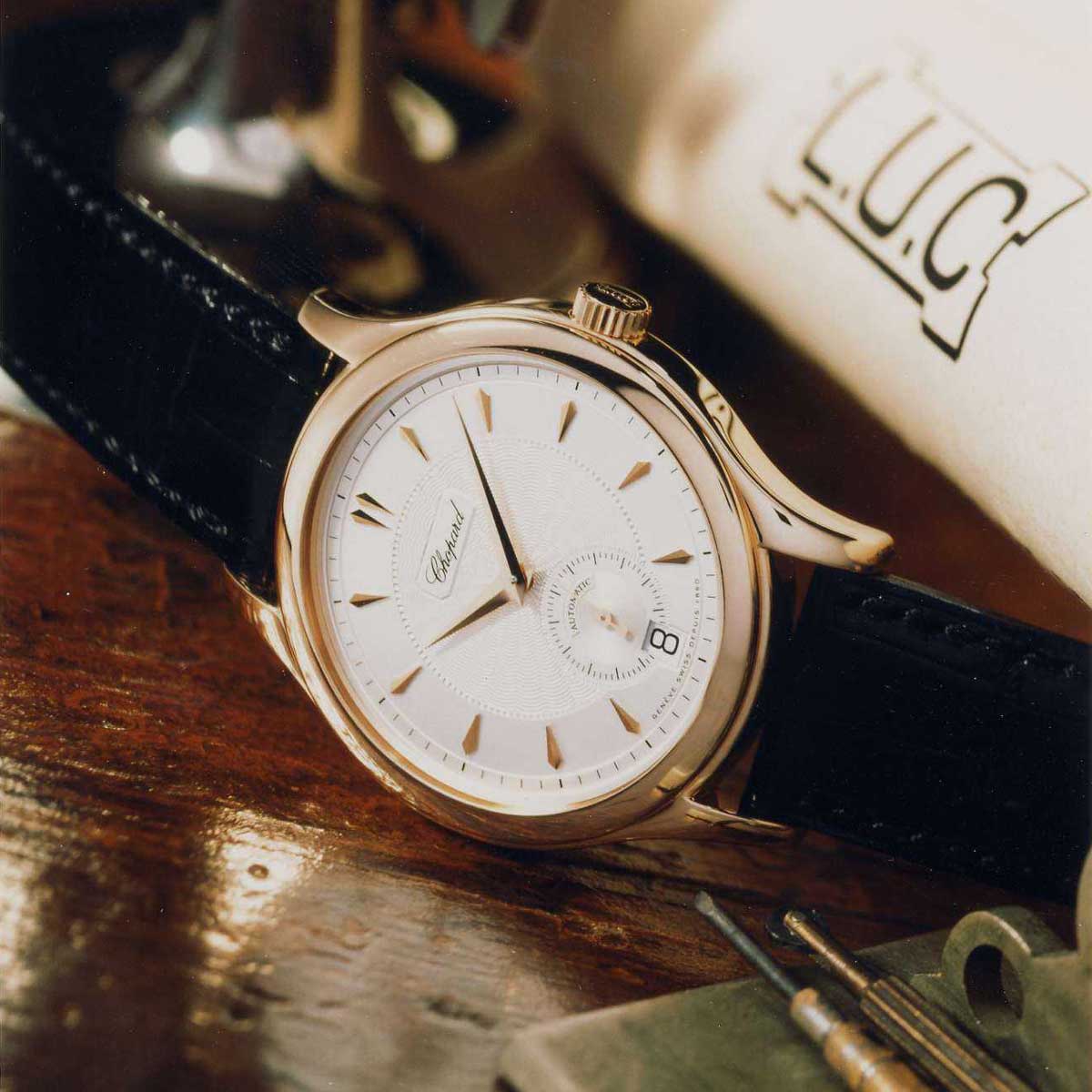
1997 — 1860 watch, a sublime 36.5mm timepiece with a massive gold dial produced by Metalem wins Timezone and Montres Passion / Uhrenwelt’s Watch of the Year.
It ran at a blistering 4Hz, or 28,800 vibrations per hour, featured an elegant swan neck regulator, received the Geneva Seal as a testimony to its peerless finish, and COSC certification as a chronometer as irrefutable proof of its accuracy. Famed watch journalist Nick Foulkes says, “Since the beginning of Chopard L.U.C, Karl-Friedrich Scheufele has insisted on these two certifications — one for beauty and one for chronometry — as a demonstration of the authenticity and quality of his watches. But this is because he is as authentic and qualitative a human being as I have ever known.”
Masterpiece of Classic Watch Design
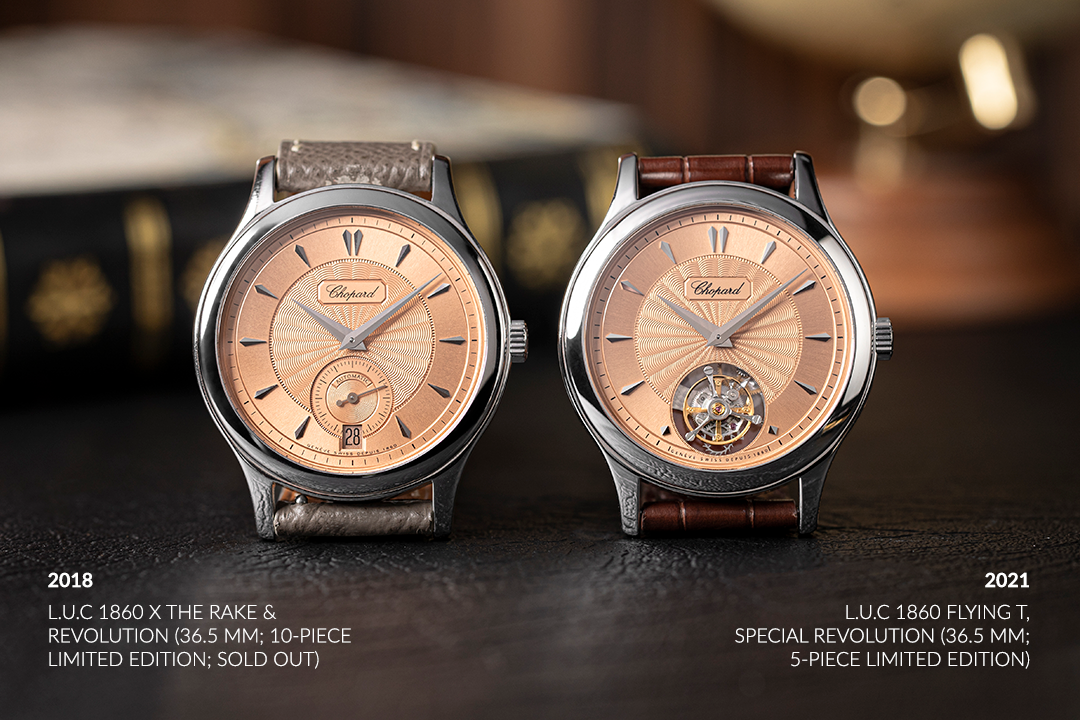
(L-R) In 2018, Mr Scheufele bestowed upon us the privilege to create the Chopard L.U.C 1860 x The Rake & Revolution, which was a limited edition of 10 pieces measuring 36.5mm in diameter and 7.2mm in height, a direct homage to the 1997 original Chopard L.U.C 1860 powered by the calibre 1.96; in 2021 story now continues with the Chopard L.U.C 1860 Flying T, Special Revolution, limited to just 5 pieces, again homage to the 1997 L.U.C 1860, but now fitted with a 3.5 Hz tourbillon within a case that measures 36.5mm in diameter and an extra 1mm of height of 8.2mm, to accommodate the tourbillon regulating organ (©Revolution)
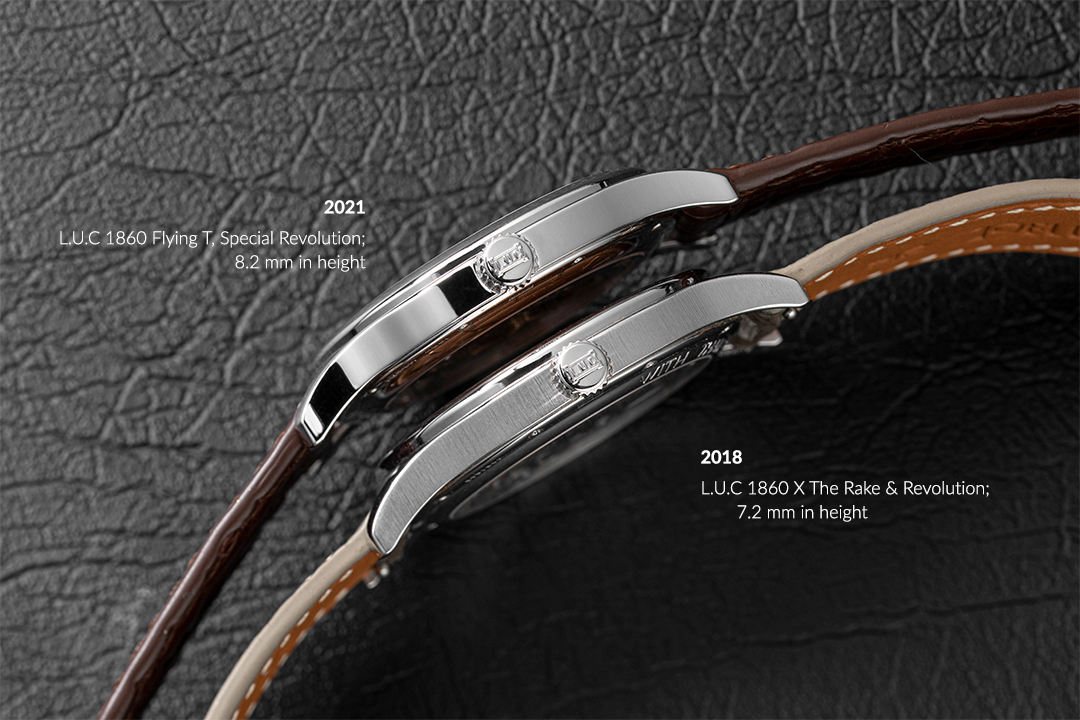
(L-R) In 2018, Mr Scheufele bestowed upon us the privilege to create the Chopard L.U.C 1860 x The Rake & Revolution, which was a limited edition of 10 pieces measuring 36.5mm in diameter and 7.2mm in height, a direct homage to the 1997 original Chopard L.U.C 1860 powered by the calibre 1.96; in 2021 story now continues with the Chopard L.U.C 1860 Flying T, Special Revolution, limited to just 5 pieces, again homage to the 1997 L.U.C 1860, but now fitted with a 3.5 Hz tourbillon within a case that measures 36.5mm in diameter and an extra 1mm of height of 8.2mm, to accommodate the tourbillon regulating organ (©Revolution)
The dial starts off as a disc of massive gold, and then receives a hand-application of stunning rose-motif guilloché emanating in waves from the center pinion. So exquisite and fine is the pattern on the dial that it creates a sense of luxuriant undulating momentum as light and shadow play sensually across its minute textures. This is perfectly complemented by an incredibly fine sunray brushing at the rehaut that is so lightly applied, it can really only be identified in strong light under a loupe.
Affixed upon this stunning dial are mirror-polished arrowhead-shaped hour indices. It gives me great pleasure that these striking indices play a very large role in all of Chopard L.U.C’s 25th anniversary watches. The sunken seconds subdial receives a contrasting circular guilloché and is framed by a large, legible seconds track as befits a watch with chronometer-level performance. A date window is integrated at six o’clock and the date disc is matching in tone, but subtly frosted in finish to help with the spatial separation.
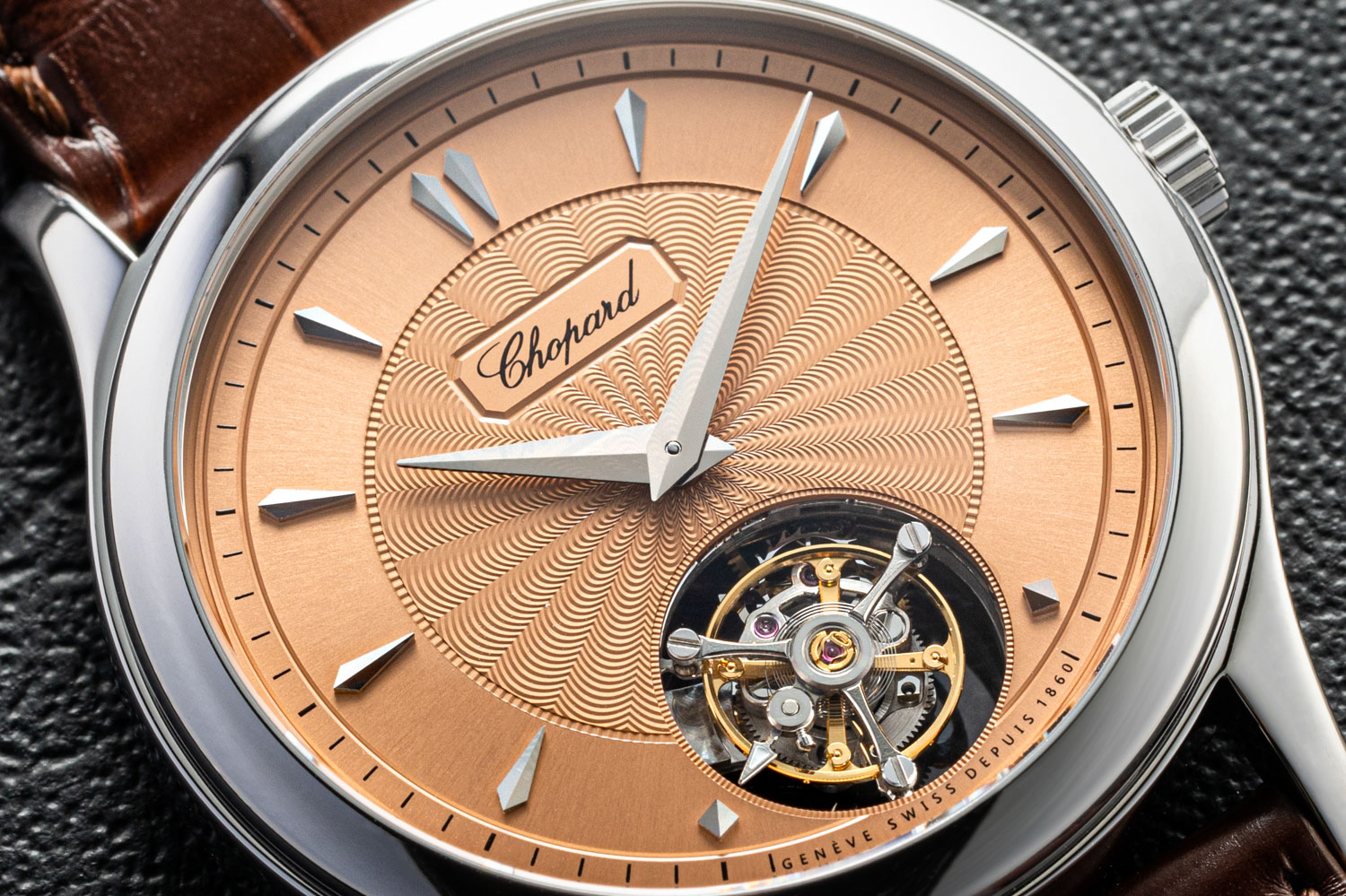
The Chopard L.U.C 1860 Flying T, Special Revolution features a solid gold copper-colored dial achieved by galvanic treatment produced by Metalem, the same manufacture responsible for the dial on Philippe Dufour’s Simplicity (©Revolution)
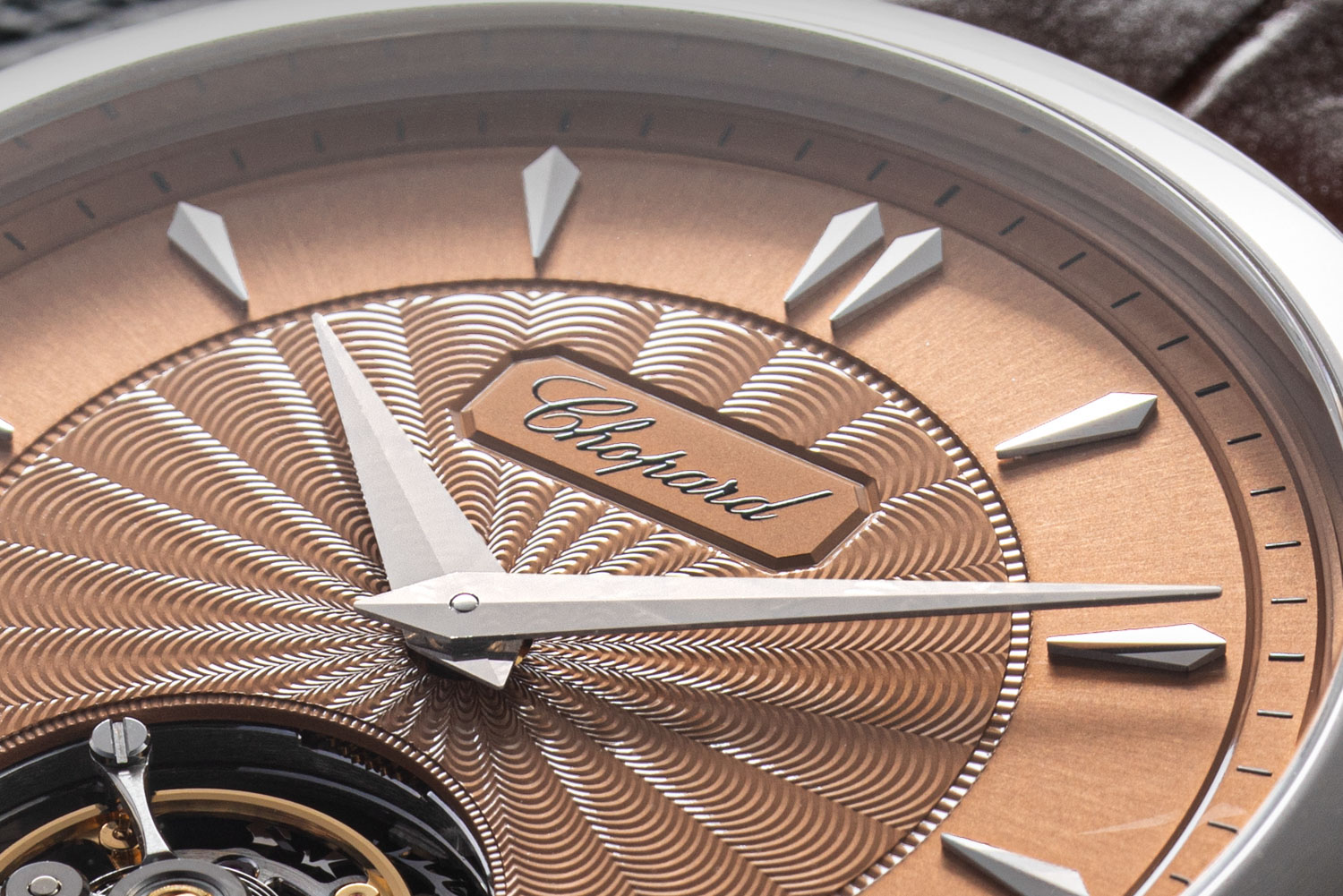
Central medallion with hand guilloché motif recalling the first L.U.C 1860 watch on the dial of the Chopard L.U.C 1860 Flying T, Special Revolution (©Revolution)
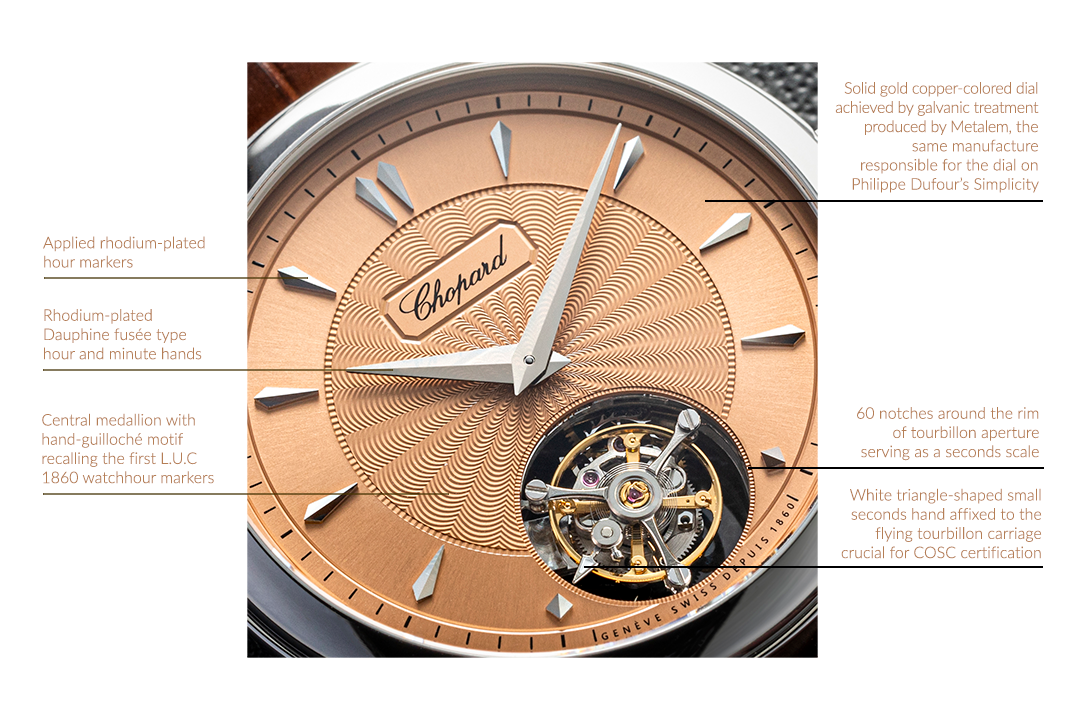
Chopard L.U.C 1860 Flying T, Special Revolution labeled diagram (©Revolution)
My incredible affection for this watch was well chronicled in 2018 when we released a limited-edition homage to the 1860 in white gold, with a stunning salmon-colored dial. To continue the story created by this first partnership, it was decided by Karl-Friedrich Scheufele that this new timepiece should feature exactly the same configuration of a white-gold case and a salmon dial.
Read more about the Chopard L.U.C 1860 x The Rake & Revolution Limited Edition, here.
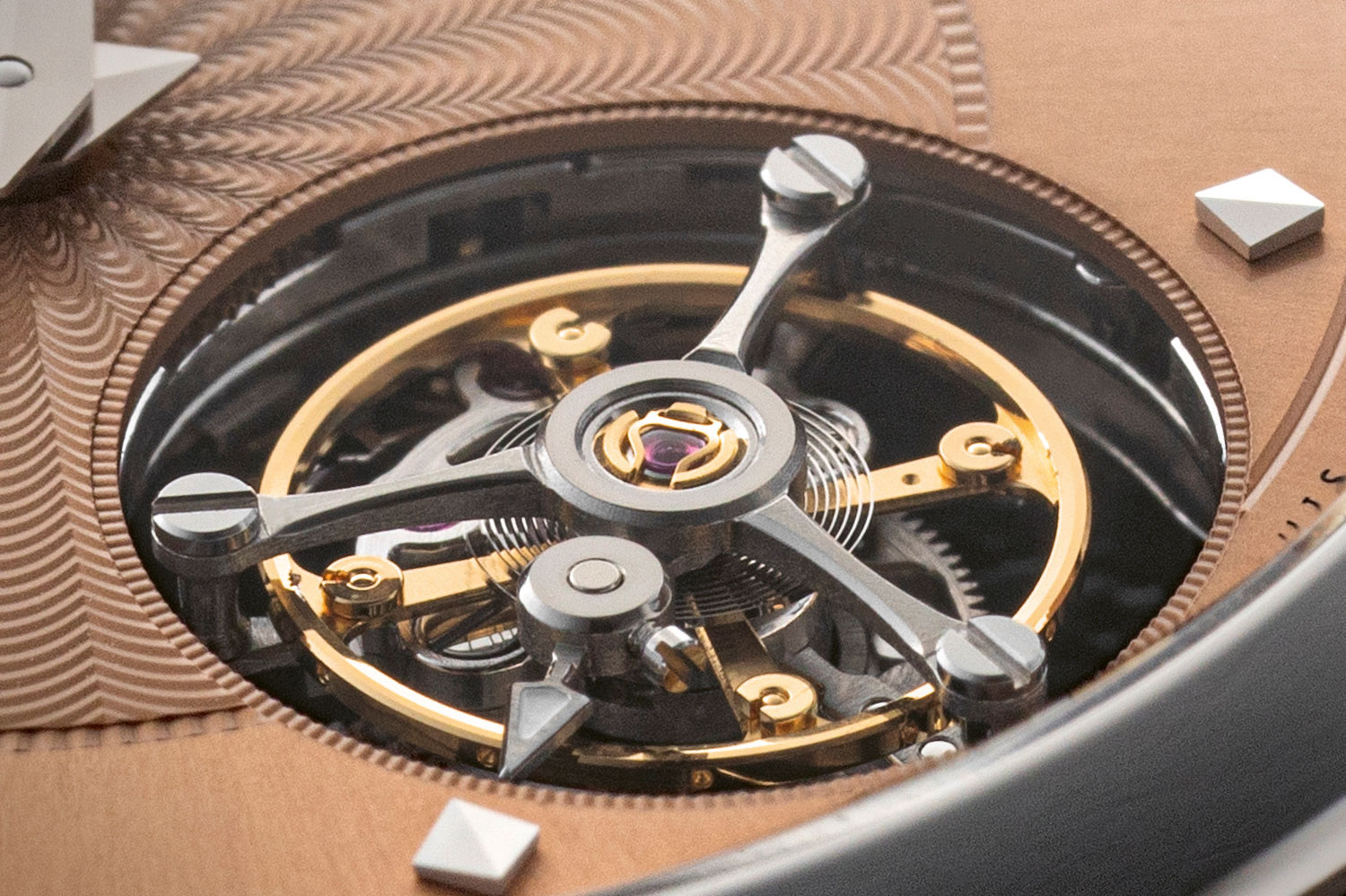
White triangle-shaped small seconds hand affixed to the flying tourbillon carriage crucial for COSC certification; notice also the 60 notches around the rim of tourbillon aperture serving as a seconds scale (©Revolution)
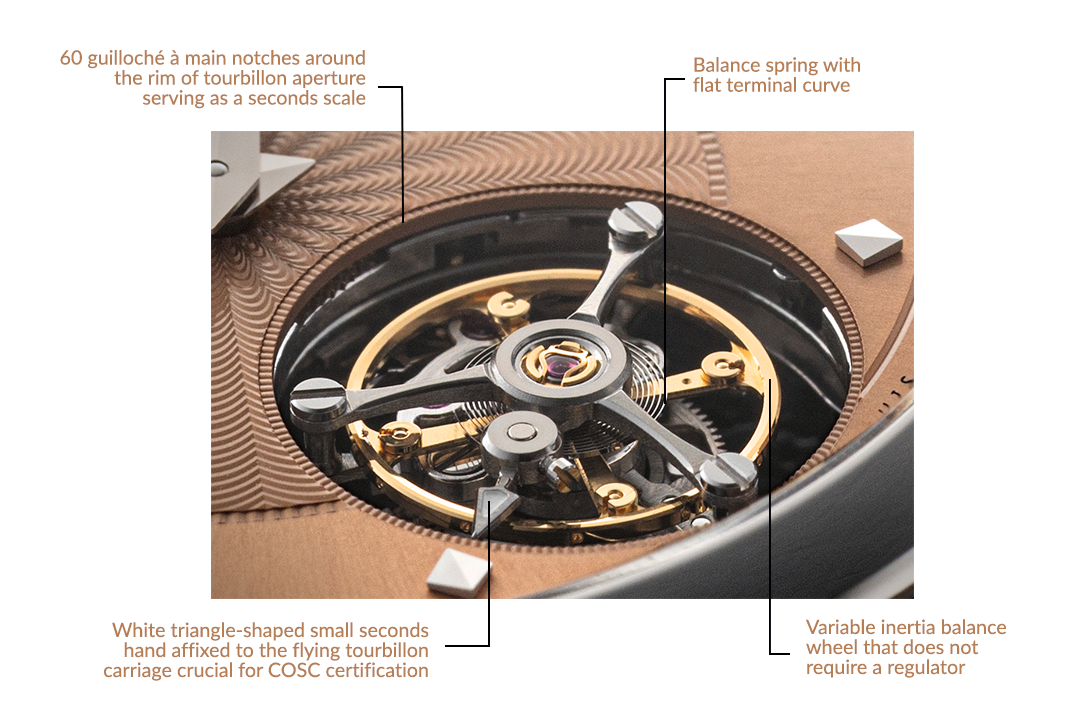
White triangle-shaped small seconds hand affixed to the flying tourbillon carriage crucial for COSC certification; notice also the 60 notches around the rim of tourbillon aperture serving as a seconds scale (©Revolution)
The L.U.C 1860 Flying T, Special Revolution
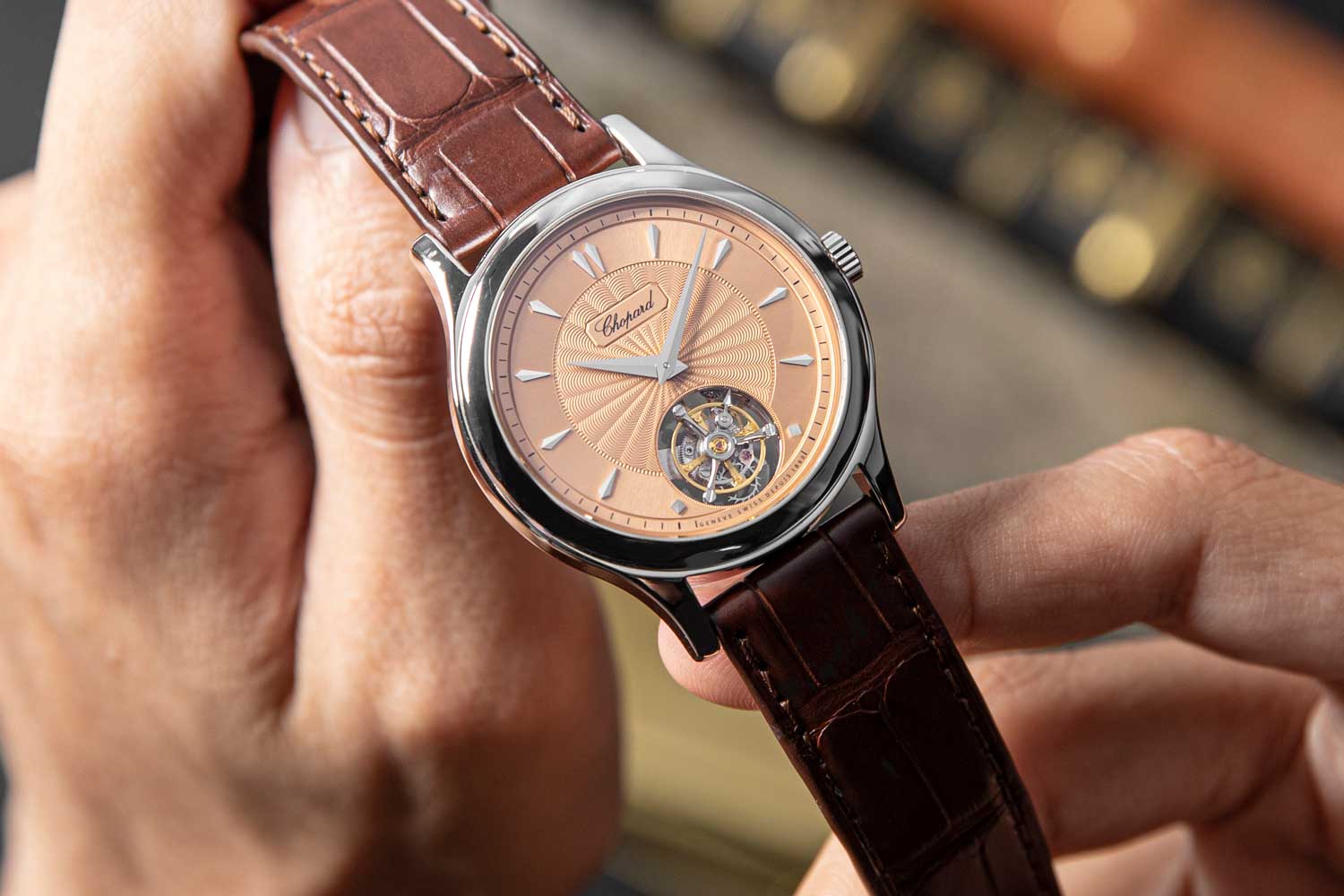
The Chopard L.U.C 1860 Flying T, Special Revolution is an aesthetic masterpiece that, in our opinion, takes one of the most iconic modern watch designs and adds to it a stunning flying tourbillon (©Revolution)
Among these was a stunning automatic flying tourbillon named the Flying T Twin. A flying tourbillon is distinguished by having no upper bridge. Instead, all the weight of the cage, the balance and the escapement is supported by the pinion of the cage from behind. This is considered to be one of the greatest horological achievements and one of the masterworks of high complication beauty, as you are able to enjoy the view of what Breguet referred to as the “whirlwind” unobstructed by any impediment.
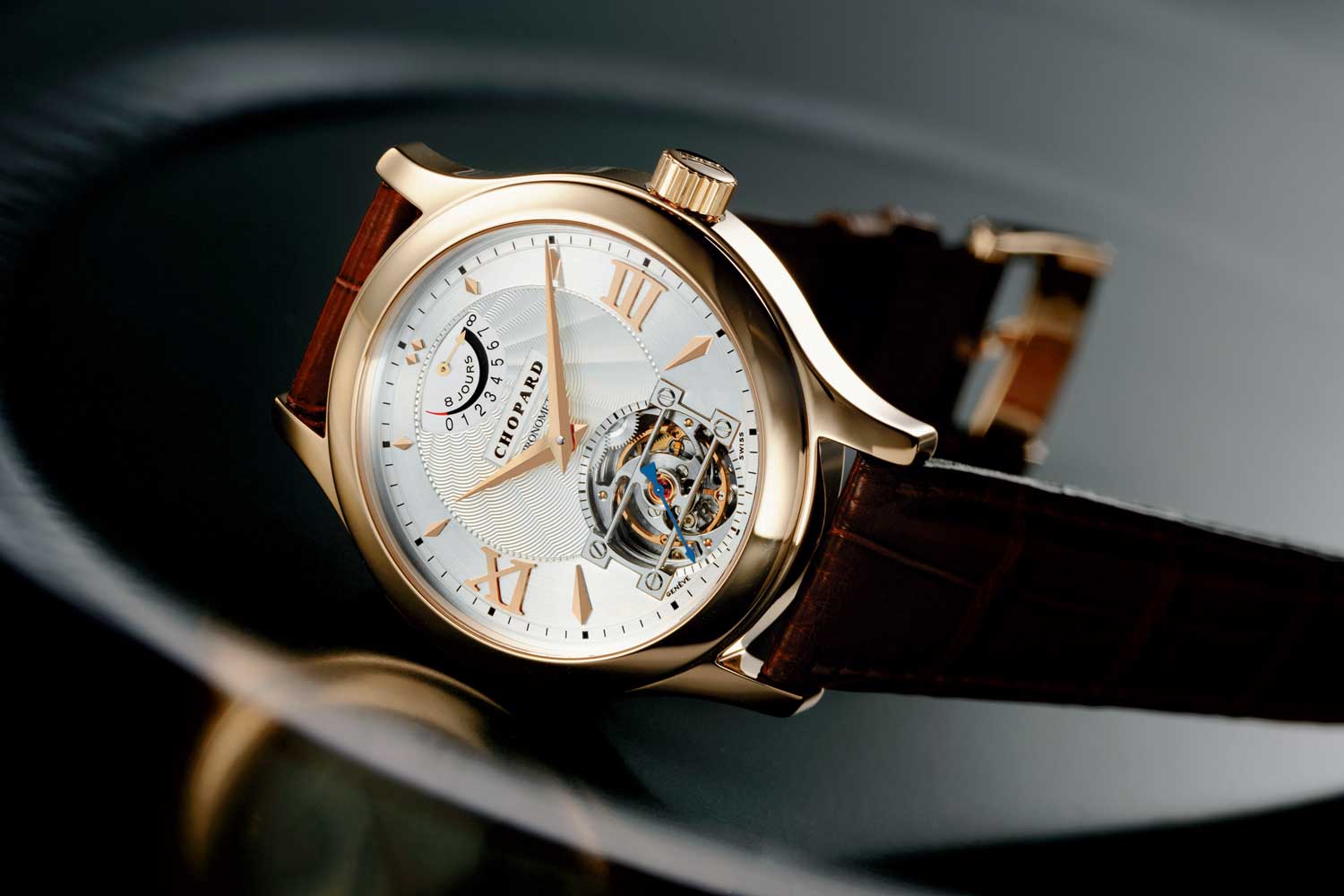
In 2004, the L.U.C Tourbillon was unveiled, which at that point in time unlike the majority of other tourbillons beat at 4Hz and was the only COSC-certified tourbillon on the market aside from Patek Philippe’s
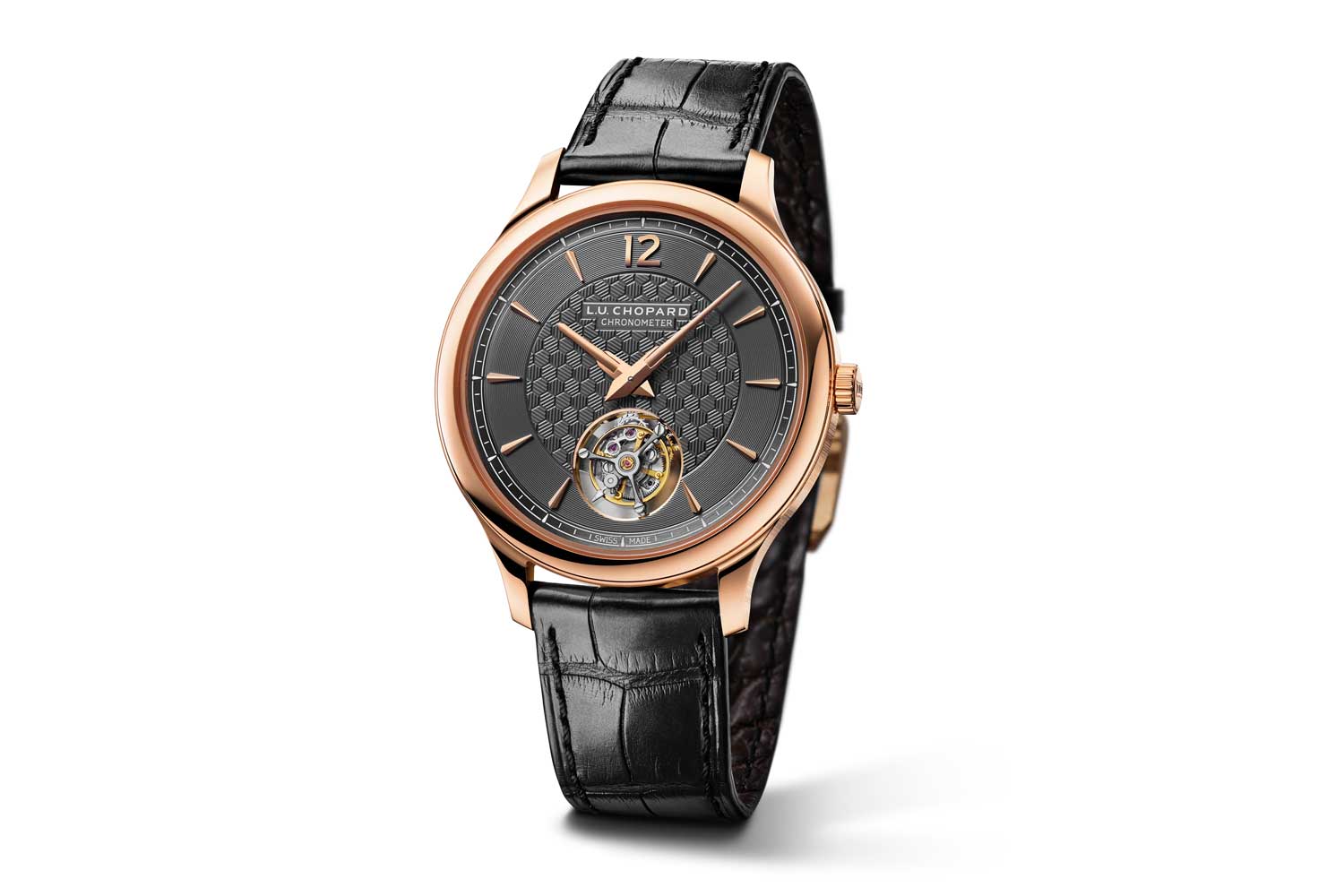
Launched at Baselworld 2019, the 40mm Chopard L.U.C Flying T Twin was powered by the L.U.C 96.24-L self-winding mechanical movement which was developed using the Caliber 1.96 as its base movement, therein, presenting the possibility of placing the movement into a watch that is of the same dimensions as the original 1860 at 36.5mm diameter
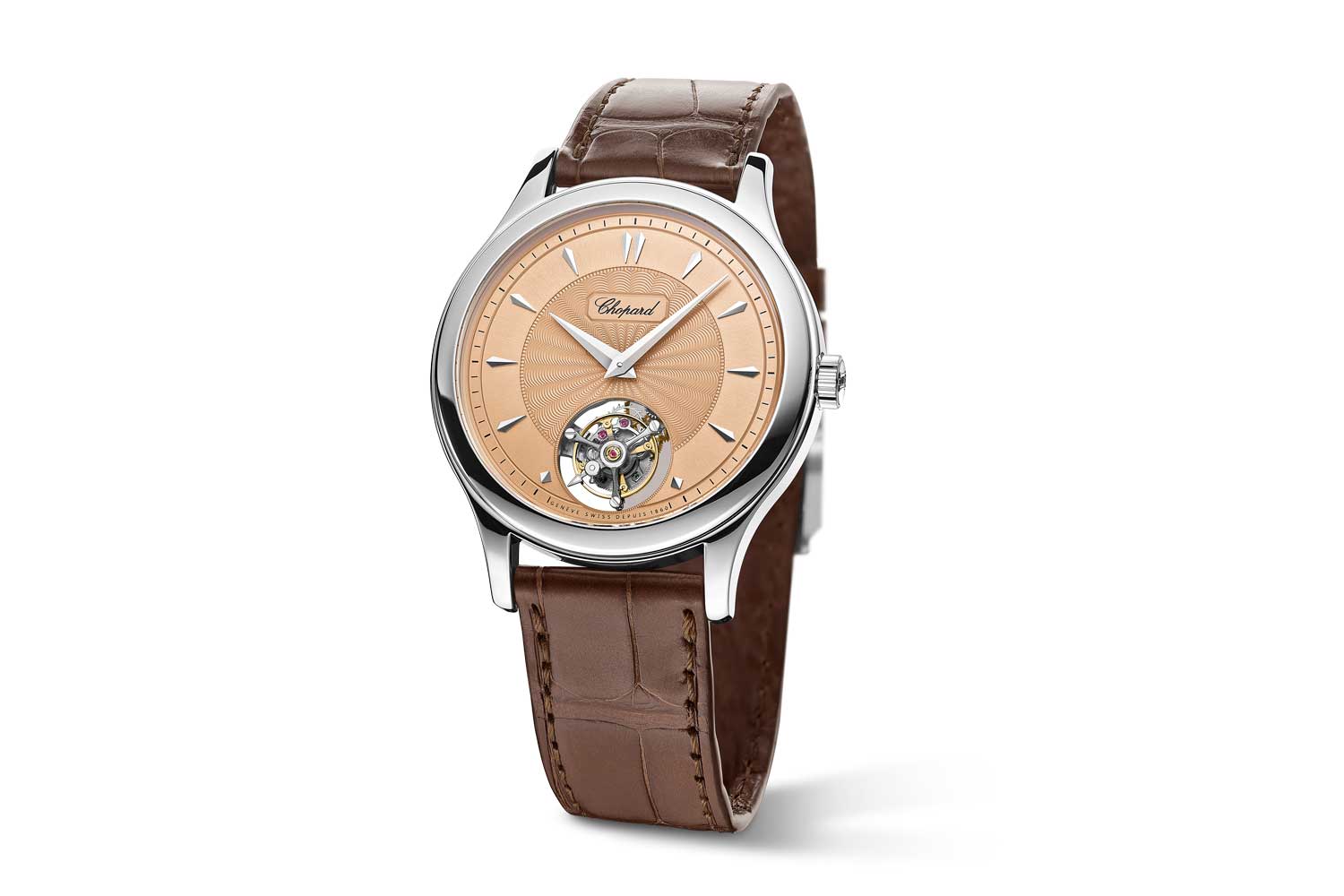
The L.U.C 96.24-L self-winding mechanical movement of the 40mm Chopard L.U.C Flying T Twin is able to fit within a case that is vastly smaller at 36.5mm because it was developed using the Caliber 1.96 as its base movement
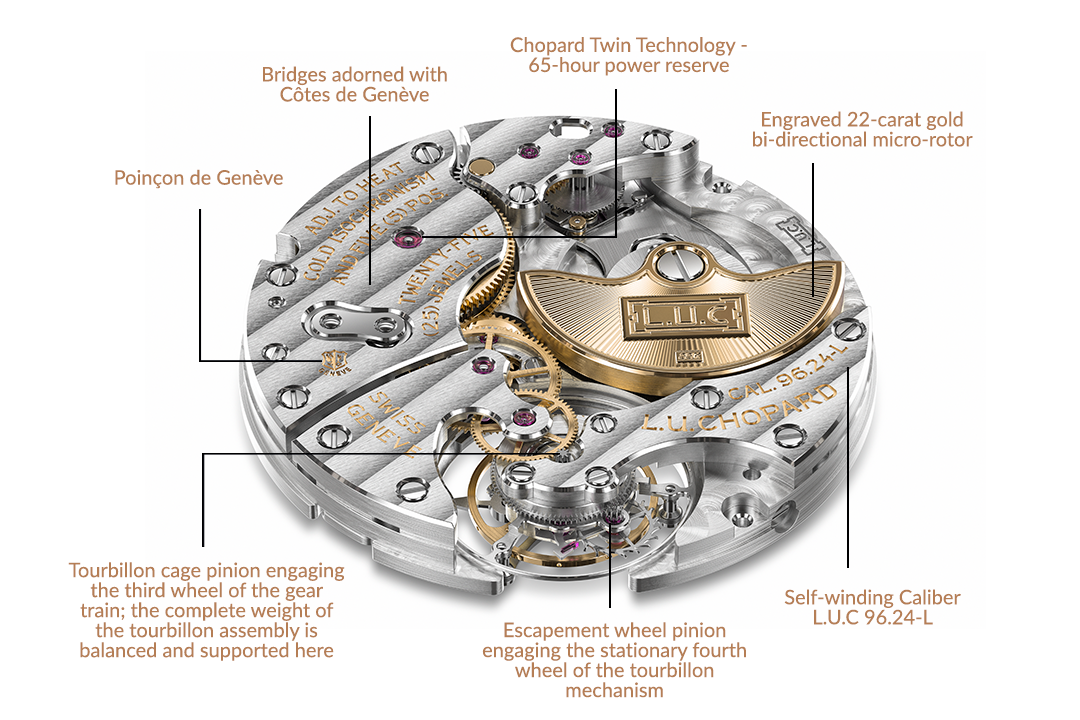
The L.U.C 96.24-L mechanical movement with automatic winding
Suddenly, I felt overwhelmed with an idea so tantalizing that I was almost afraid to articulate it in case it were not possible; I’d be crushed by the disappointment. While the new Flying T Twin was 40mm in diameter, it dawned on me that it might be possible to make a much smaller version of the watch. I asked Karl-Friedrich, “Does this mean that you could conceivably create a flying tourbillon watch in exactly the same dimensions as the original 1860 watch?”
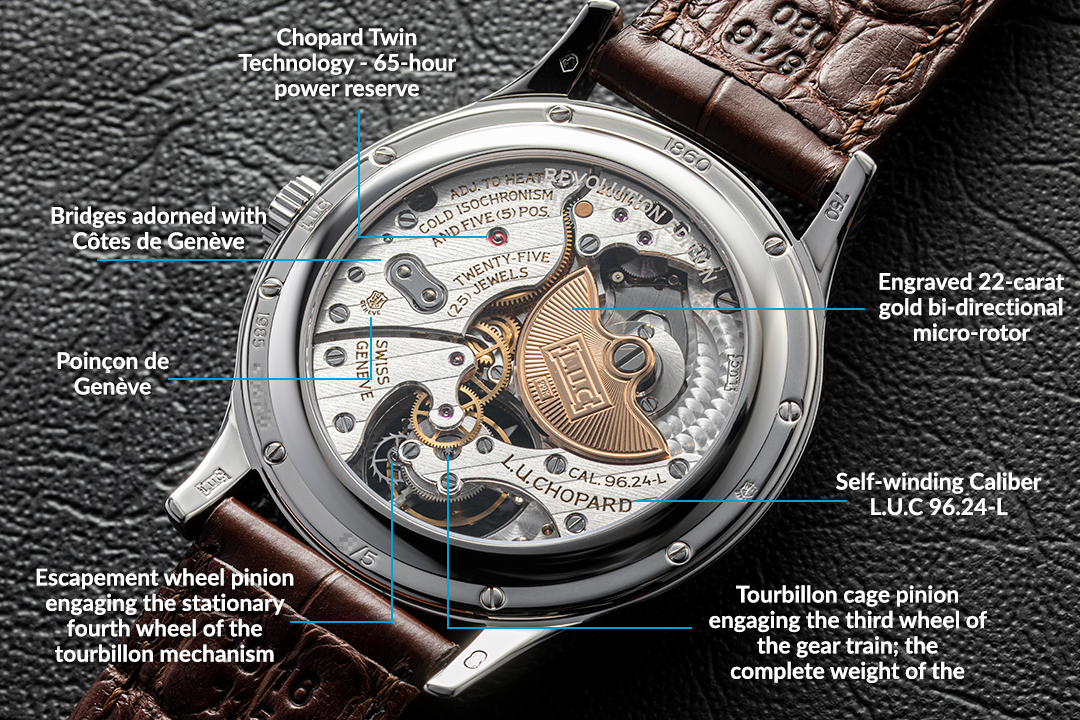
The L.U.C 96.24-L mechanical movement with automatic winding seen here visible through the display caseback of the L.U.C Flying T Twin, Revolution Edition Ref. 161985-1001 (©Revolution)
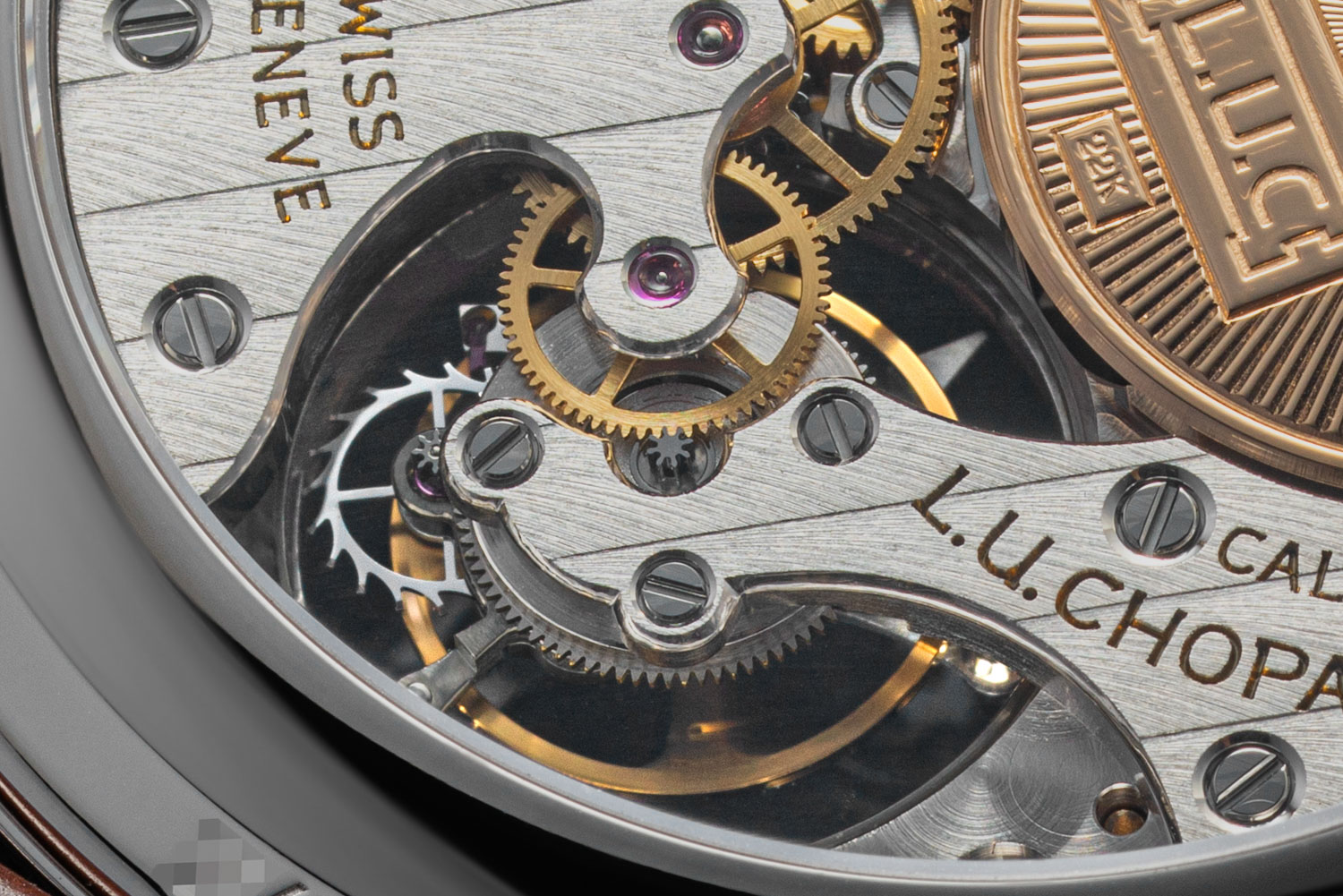
A close look at the tourbillon cage pinion seen here on the underside of the carriage, engaging the third wheel of the gear train; the complete weight of the tourbillon assembly is balanced and supported here (©Revolution)
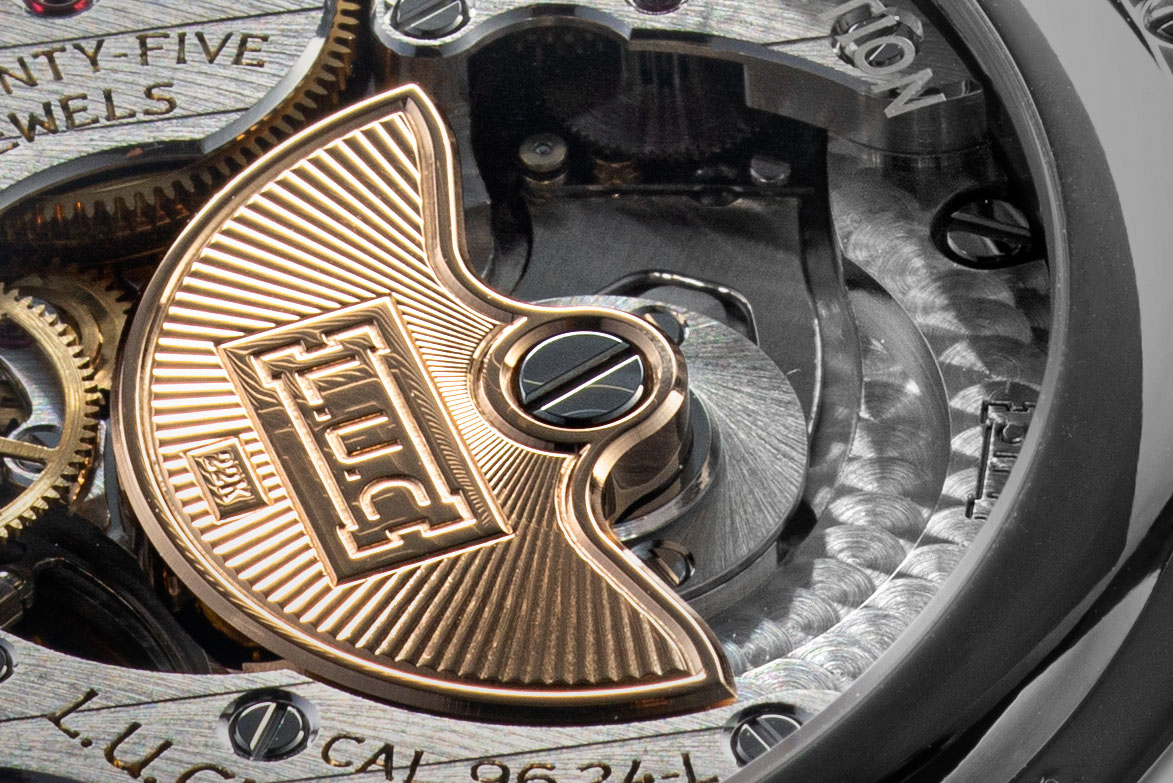
The engraved 22-carat gold bi-directional micro-rotor of the L.U.C 96.24-L (©Revolution)
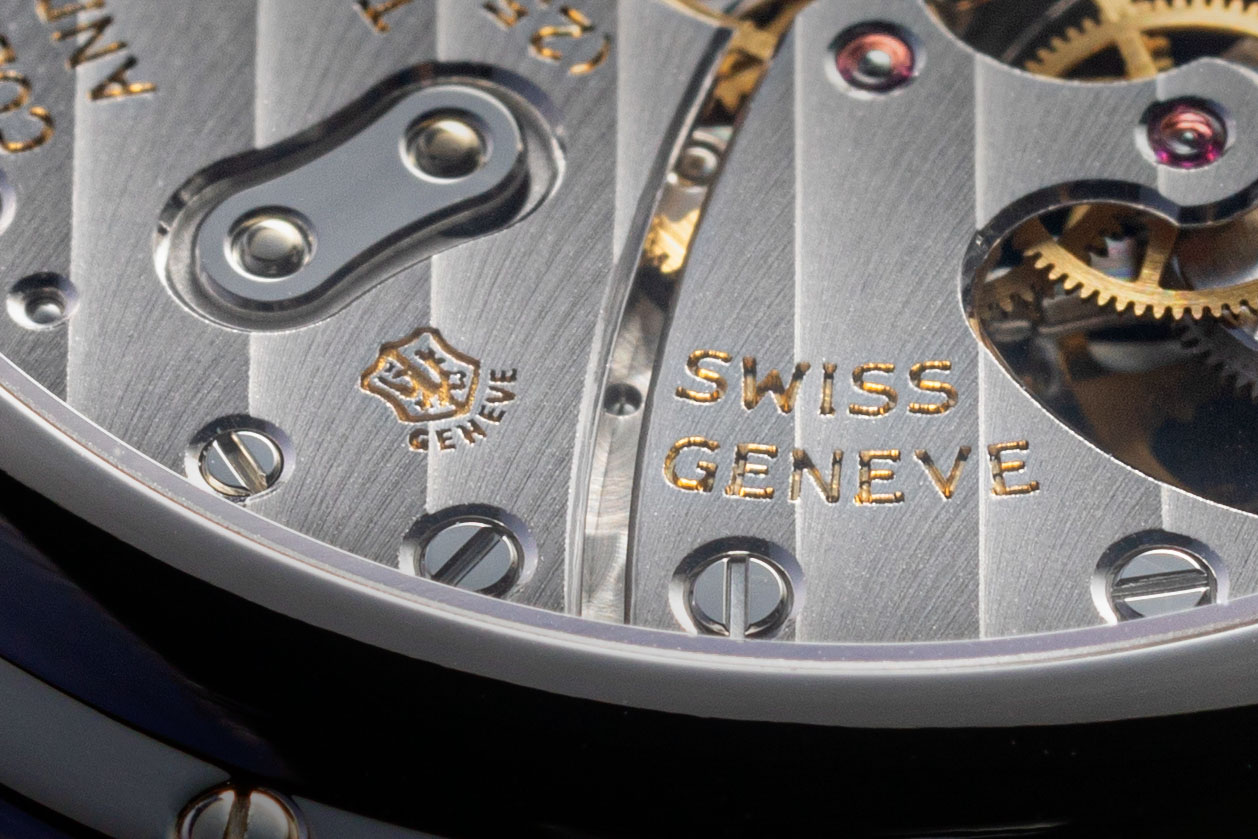
The L.U.C Flying T Twin, Revolution Edition is double certified with a recognition of its high craft in the Poinçon de Genève and of its chronometry in the industrial standard that is the COSC certification (©Revolution)
So here’s a breakdown of why I feel that the L.U.C 1860 Flying T, Special Revolution is such an extraordinary watch. First, the watch is a celebration of L.U.C’s incredible 25-year-long commitment to technical innovation and pure authentic watchmaking. Second, it is an aesthetic masterpiece that takes one of the most iconic modern watch designs and added to it a stunning flying tourbillon.
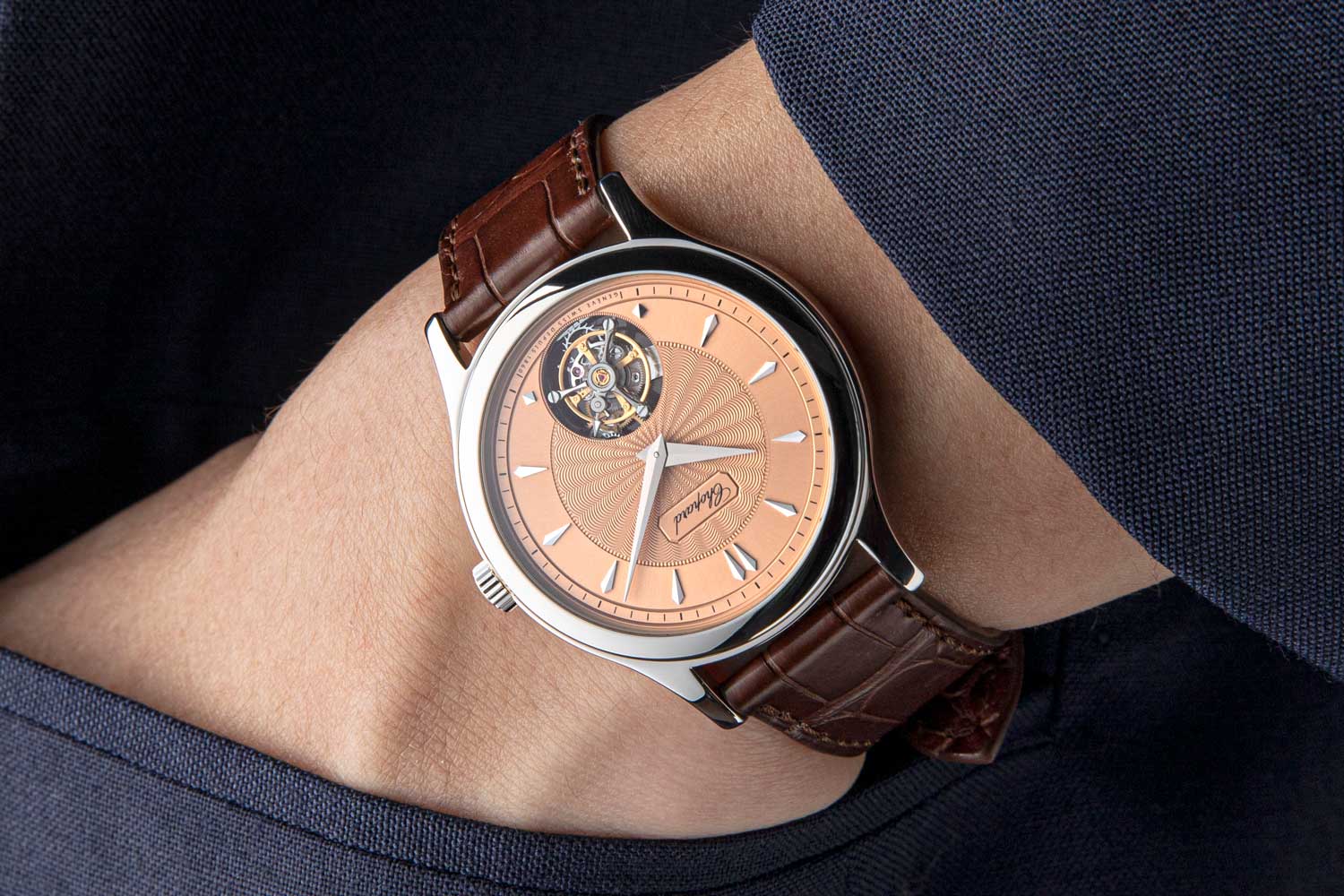
The Chopard L.U.C 1860 Flying T, Special Revolution is one of the world’s smallest automatic flying tourbillon at 36.5mm in diameter and 8.2mm in height, and it is to our minds the perfect size for a complicated classic dress watch (©Revolution)
Fourth, it is the only automatic flying tourbillon that has received both the Geneva Seal as well as COSC certification. Last but not least, thanks to Chopard L.U.C’s understanding, we have been permitted to price this timepiece at what we consider a tremendous value proposition at USD 121,000.
Technical Details: L.U.C Flying T Twin, Revolution Edition Ref. 161985-1001
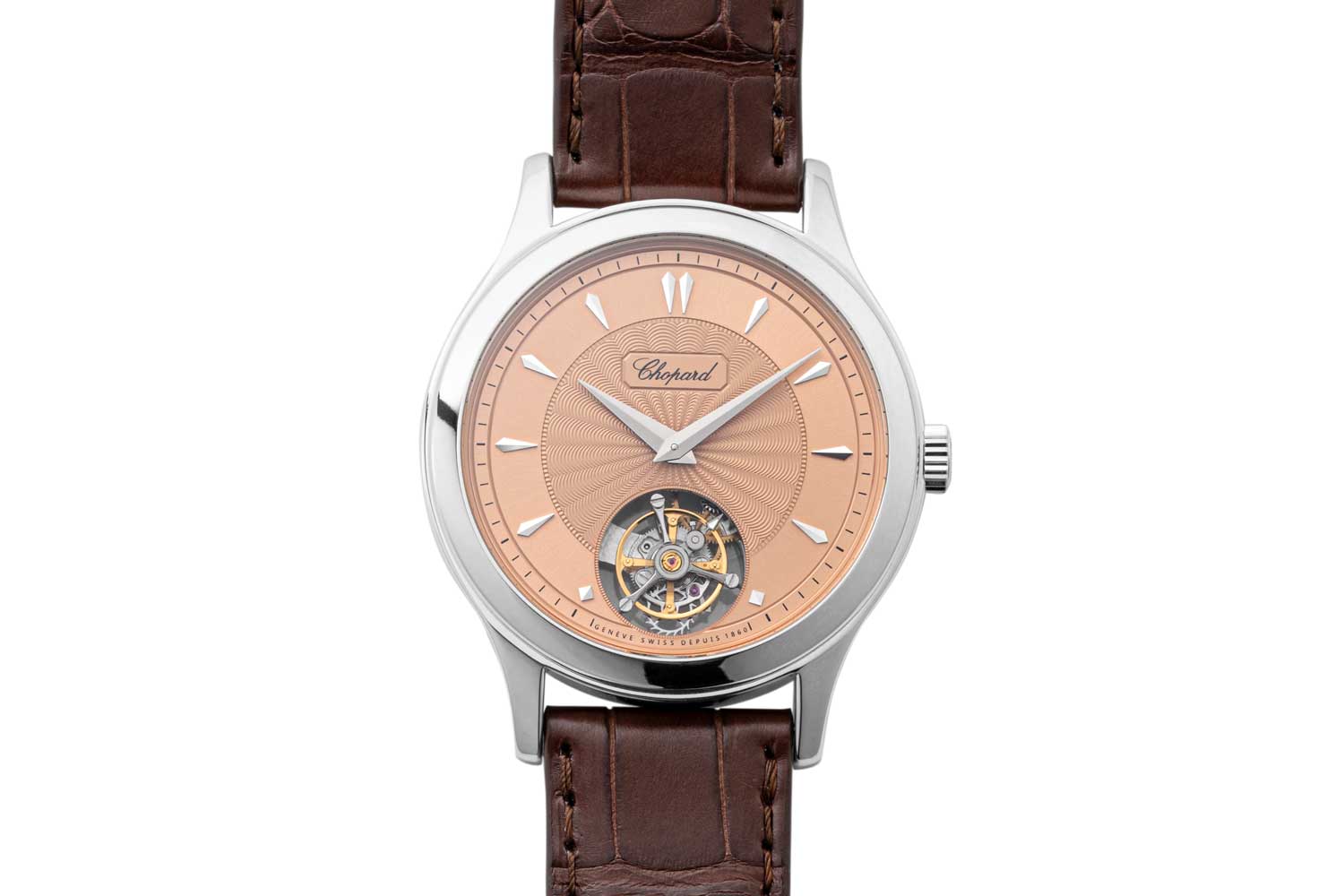
The Chopard L.U.C 1860 Flying T, Special Revolution (©Revolution)
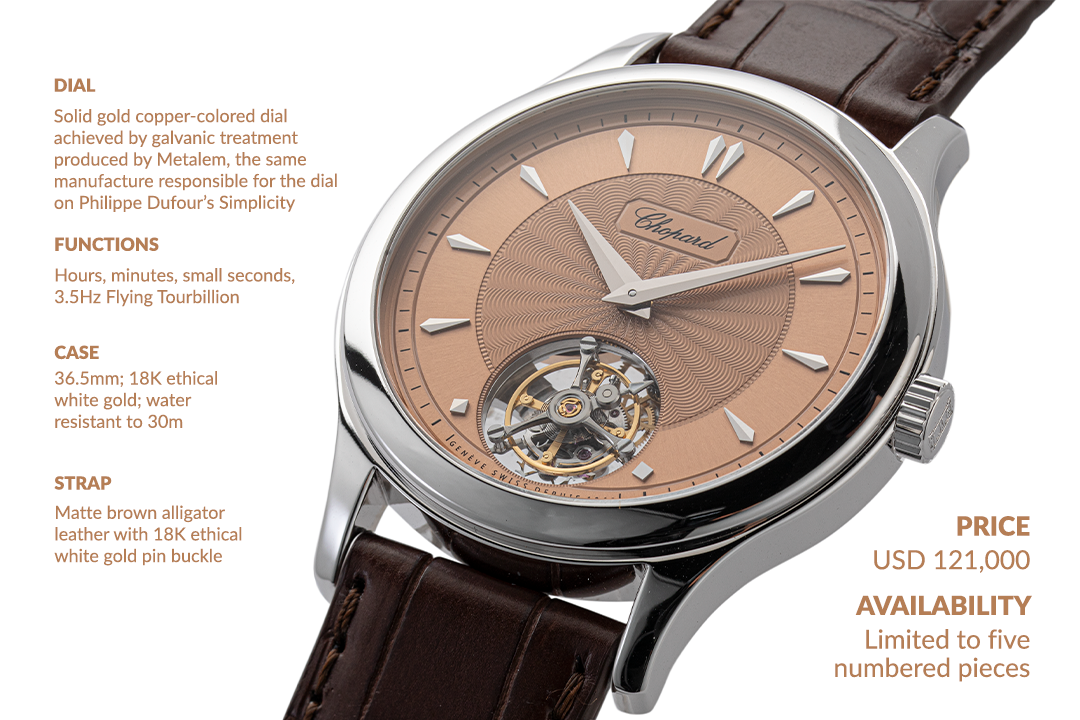
The 36.5 mm in diameter and 8.2 mm in height, Chopard L.U.C 1860 Flying T, Special Revolution (©Revolution)
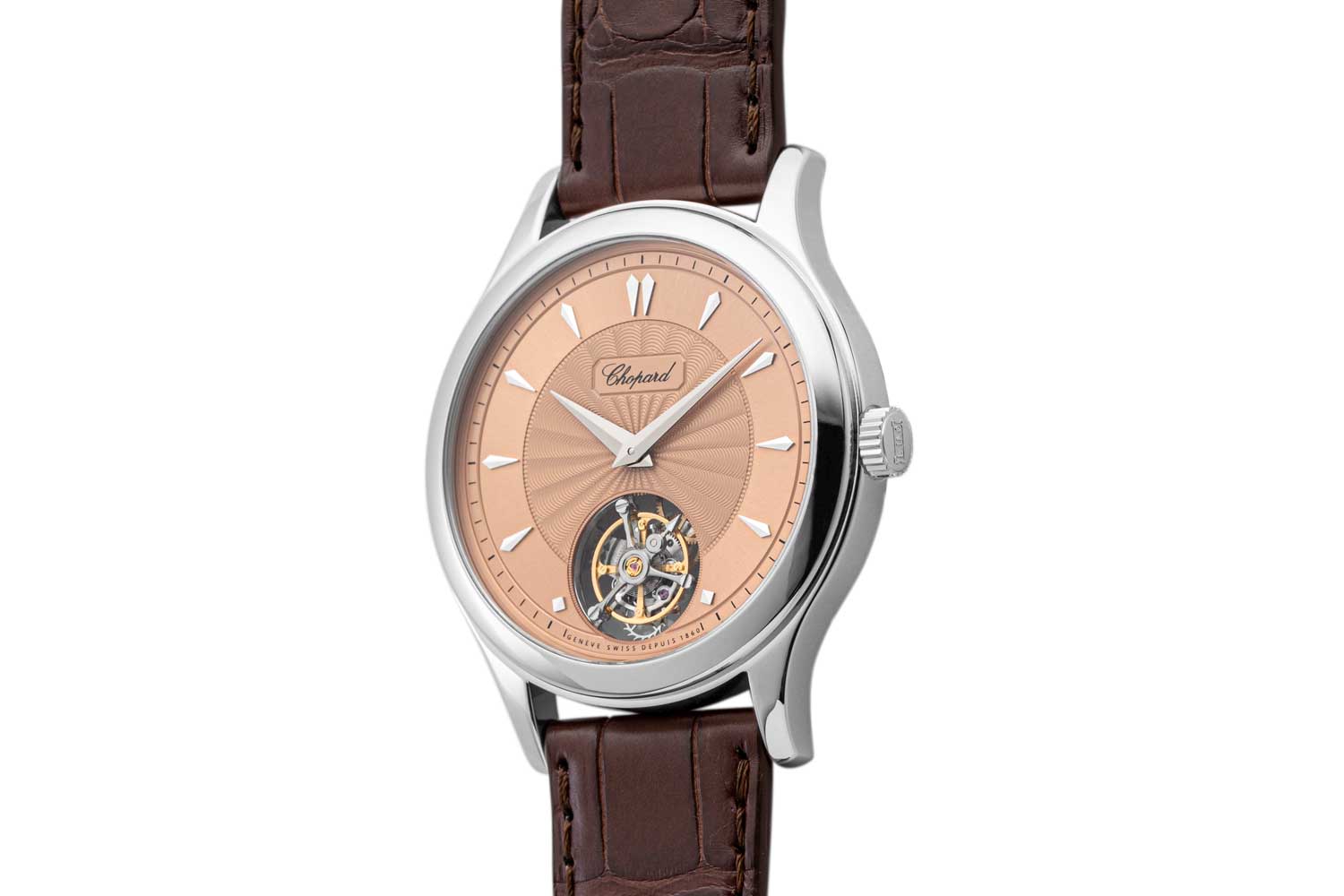
The Chopard L.U.C 1860 Flying T, Special Revolution (©Revolution)
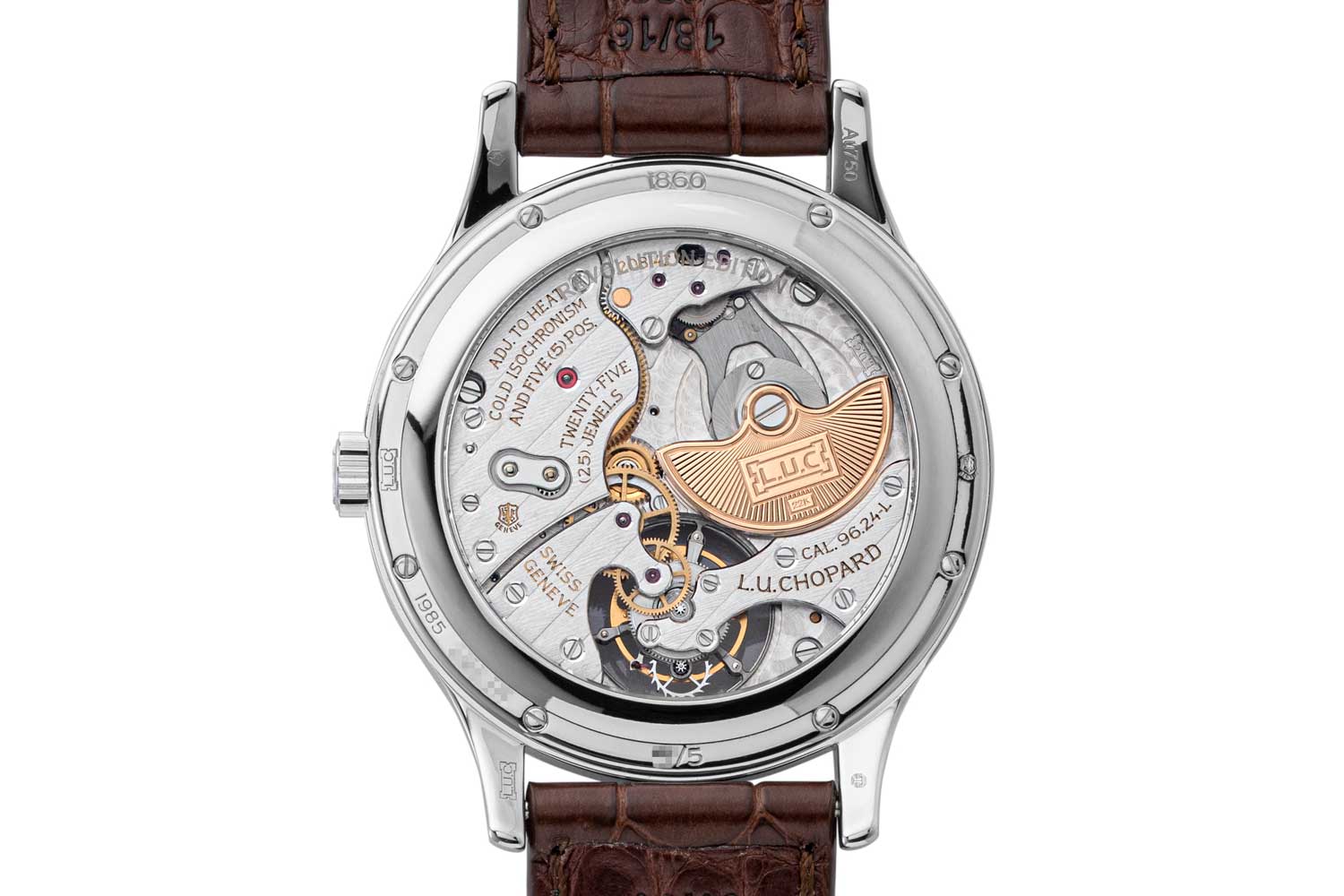
The Chopard L.U.C 1860 Flying T, Special Revolution (©Revolution)
Movement: L.U.C 96.24-L mechanical movement with automatic winding; winding via an engraved 22-carat gold micro-rotor; number of components: 190; total diameter: 27.40mm; thickness: 3.30mm; number of jewels: 25; frequency: 25,200vph (3.5Hz); power reserve: 65 hours; flying tourbillon performing one rotation per minute; two barrels – Chopard Twin Technology; bridges adorned with Côtes de Genève pattern; variable-inertia balance wheel; balance-spring with flat terminal curve; Chronometer-certified (COSC); Poinçon de Genève
Dial & Hands: Solid gold copper-coloured dial achieved by galvanic treatment; snailed hour ring; railway-type minutes track; applied rhodium-plated hour-markers; central medallion with hand-guilloché motif recalling the first L.U.C 1860 watch; rhodium-plated Dauphine fusée-type hours and minutes hands; white triangle-shaped small seconds hand affixed to the flying tourbillon carriage
Functions & Displays: Central display of the hours and minutes; small seconds appearing at 6 o’clock on the flying tourbillon carriage
Strap & Buckle: Hand-sewn matt brown alligator leather strap with brown alligator leather lining; 18-carat ethical white gold pin buckle
Price: USD 121,000
Availability: Limited edition of five numbered pieces, exclusively available from Revolution
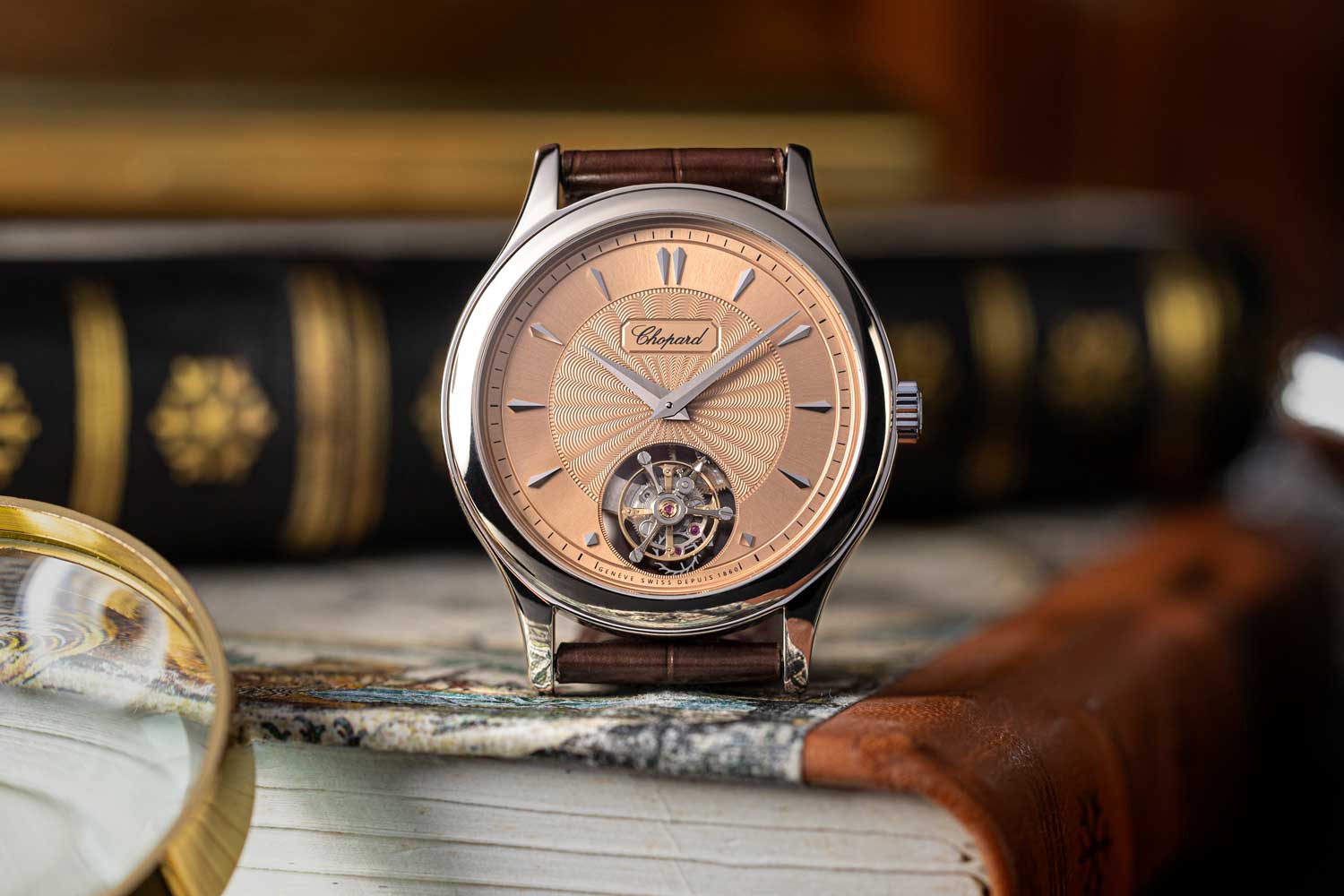
The Chopard L.U.C 1860 Flying T, Special Revolution (©Revolution)










